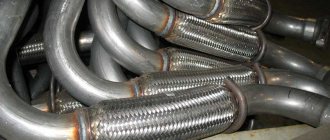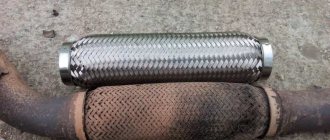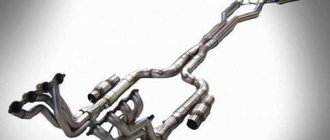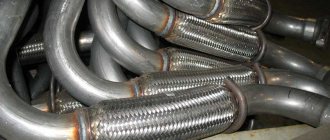There are fans of direct-flow exhaust, when a loud roar of the engine is heard. But there are also those who think about how to reduce the sound of the muffler. If you make a quiet muffler with your own hands, then the ride will be more comfortable, because the cabin will be quieter. Especially on domestic cars like the VAZ 2109, the question of how to make a silent muffler is relevant. If you can make a quiet muffler on the nine, then the car will bring more joy to its owner.
How to make a quiet muffler on a car - tuning the silence
Only a small part of car enthusiasts would like to have a loud sports exhaust on their car. The vast majority of drivers, on the contrary, are puzzled by the question of how to make a quiet muffler. Driving can be comfortable only if as little extraneous sounds as possible enter the cabin. The muffler creates its own background noise, which can be significantly reduced. The effect of this cannot be ignored.
Basic ways to make a muffler quieter
Before you begin upgrading your exhaust system, you should understand the nature of the increased exhaust sound. With each working stroke of the piston, a micro-explosion occurs in the combustion chamber of the engine cylinder, which is accompanied by a significant sharp expansion of gases. Naturally, a kind of blast wave, after it has done its job and moved the piston down, rushes through the exhaust system with the opening of the exhaust valve.
Thus, the nature of exhaust system noise is twofold:
- sound from expansion of gases;
- noise from vibration of exhaust system elements.
As you know, the main way to combat noise is to increase the weight of the elements. The thicker the metal, the less vibration and, accordingly, noise. That is why the exhaust manifold, which is the first to absorb hot gases from the cylinder head, is made so massive. Many car enthusiasts who had the opportunity to compare the weight of the exhaust pipe of a domestic car and a foreign one noted that the exhaust system parts of foreign cars are much heavier. This is why “our” cars are less comfortable in sound and noise comparisons.
Special elements are designed to reduce the speed of gas movement in the exhaust pipe: resonators and mufflers. First in line is the resonator. As soon as gases under pressure enter a part of the pipe with an increased volume, they immediately lose some of their energy and move further with less momentum. In the muffler labyrinth system, the exhaust gases finally lose their energy and are dissipated. A real quiet muffler on a foreign car is quite heavy and has several separate housings.
Do-it-yourself quiet muffler, video:
Making a quiet muffler with your own hands
When starting to modernize the exhaust system in order to reduce exhaust sound, you should be prepared technically and financially. For work you will need a full set of car mechanic tools. In addition, you will definitely need:
- welding machine (preferably semi-automatic or inverter);
- angle grinder with a set of discs;
- a workbench equipped with a vice.
One of the most affordable ways to get a quiet muffler in the average garage is to include an additional resonator in the existing exhaust system.
There are also two options for upgrading the exhaust system: installing an additional factory-made resonator in the area between the main resonator and the muffler, or making the device yourself.
When considering how to make a muffler quieter, it should be borne in mind that any of the options may entail different costs. If the car enthusiast is not limited by budget, then you can safely buy a new resonator, cut out part of the pipe and weld it into the free space. The second method turns out to be more exciting and should be described in more detail.
The manufacturing technology of an additional resonator consists of the following stages:
- manufacturing a body (barrel) from a piece of thin-walled steel pipe or sheet steel in the form of two halves;
- making holes in a section of the exhaust system pipe corresponding to the length of the body behind the main resonator;
- connecting the body halves on a pipe with holes and scalding;
- laying basalt mineral wool into the cavity of the new body;
- welding of the end parts of the resonator.
Finally, the welds should be processed, the new resonator should be cleaned and degreased, and if possible, painted with heat-resistant paint.
Video, what is an exhaust manifold and resonator?
Additional problems of a quiet car
Once the question of how to make a quiet muffler has been resolved, some problem areas become apparent. First of all, it should be remembered that any of the methods for producing a “quiet” exhaust system will certainly lead to an increase in the weight of the structure.
This, in turn, obliges the car owner to take additional measures to strengthen the brackets and rubber shock absorbers. Another point to consider is the change in the balance of air entering the engine and exhaust gases. After upgrading the exhaust system, it is imperative to test the operation of the engine in different modes and make additional adjustments to the fuel supply and air filtration system.
What to do if nothing helps?
If the above methods do not help, then check whether the exhaust system is functioning correctly, because extraneous sounds can signal a breakdown. Pay attention to the smoke that the chimney produces - it should not be thick.
Take your car to a technical inspection so that specialists can check the car to determine whether there are any problems with your muffler or perhaps the cause lies in another element of the exhaust system.
You may also be interested in our article - how to remove nameplates from a car.
DIY car muffler
The eternal craving for perfection sometimes forces us to improve the seemingly simplest things. But because of this, we get brilliant inventions and discoveries. If a potential Kulibin gets his hands on a car, it means he will definitely modify something to suit himself. Such alterations sometimes have no practical meaning, and sometimes are simply necessary. Everyone decides for themselves, but today we will talk about a car muffler.
A friend asks: maybe I should buy Gazelle Next and become a businessman? I answer him: why not?
Design and purpose of the muffler
There is nothing special about it - just a pipe. This is what people who are far from cars think. This is a fundamentally wrong opinion. The exhaust pipe carries a fairly large load and performs a number of functions that many are not aware of.
About the direct-flow system
Any car muffler reduces engine power by creating significant resistance to the flow of flue gases. This is the price you have to pay for comfort and an almost silent exhaust. But for motorists who are tuning their “iron horses”, there is an alternative option - a direct-flow type sound absorber.
The task of this element is to reduce power losses while continuing to absorb sound vibrations from engine operation. Forward flow is a compromise solution because, for the sake of power, it dampens noise not as effectively as standard car elements. What does this muffler consist of:
- metal body equipped with two pipes;
- inside there is a perforated straight pipe connecting the inlet and outlet;
- Between the body and the pipe there is a sound-absorbing material - kaolin or basalt wool.
Sounds traveling through a straight pipe with holes are partially absorbed by the fiber, but the other part passes out unhindered, because there are no partitions or resonance chambers. Therefore, cars equipped with forward flow make a rumbling sound, especially when you press the accelerator pedal.
The highest level of tuning is a combined exhaust system with a damper controlled from inside the car. With its help, the gas flow can be switched between two branches: the first has a conventional effective muffler, and the second has a forward flow. This allows you to use the power of the engine only when necessary, and under normal conditions, drive around the city without unnecessary “roar” from the exhaust pipe.
Muffler resonator
The muffler consists of several parts connected into a single whole. All this is responsible for reducing the noise level of the vehicle and being environmentally friendly. The resonator takes on the role of dampening the noise level that appears during combustion of the working mixture in the engine. Not everyone knows that the dimensions of this part depend directly on the level of noise emitted. The shape of the resonator also plays an important role.
What is a flute in a direct-flow muffler, and what is its effect?
To make the forward flow quieter and get “passing” decibels at the output, a simple design is used, which motorists call a flute. This is a piece of perforated tube with a length of 180–250 mm and a diameter of slightly more than 1/3 of the exhaust, with a welded plug washer in the form of a disk, cylinder or cone, which is bolted inside the forward flow, at the air cut, thereby allowing it to be muffled.
The principle of operation of the flute for direct flow is that when the cross-section of the exhaust channel changes and exhaust gases exit through the perforations, the following occurs:
The correct name for this flute is silencer (from the English silencer - muffler), and it is included in the set of expensive exhaust systems that are sold on the Internet. You can also purchase separately, the average price of good European models is 70–150 dollars, and mass ones from the Middle Kingdom - from 450 rubles.
Types of resonators
Like many parts, resonators are divided into types, which depend on the engines. There are resonators for two-stroke and four-stroke engines. It was experimentally found that when the resonator interacts with a four-stroke engine, the engine power decreases. If you remove the resonator, the engine will become about 15 percent more powerful. It's different with a two-stroke engine. If you remove the resonator, the power drops and more fuel is lost. Therefore, the car owner will have to overpay for gasoline in vain. In addition, the speed characteristics of the car will drop.
You can also classify resonators by appearance and dimensions.
Causes of loud exhaust
In all combustion chambers, processes occurring with the pistons located in the cylinder are necessarily accompanied by small explosions. The volume of gas instantly increases, which provokes the movement of the pistons downward. The exhaust valve then opens and a wave of gas enters the expansion of the exhaust device.
Too much noise comes from powerful mechanical vibrations in the exhaust gas outlet device. Very large expansions can contribute to loud noise. As a result, all components of the exhaust device are made of very dense and durable metal - it helps reduce noise and vibration.
A loud exhaust may be the result of a malfunction of the muffler, catalytic converter, or other parts of the exhaust system. If you are not sure that the exhaust system is in order, it is better to contact a car repair shop. However, you can try to find the cause yourself and, for example, if the old muffler or resonator is to blame, then you can replace them yourself.
Resonator repair
Most often, holes appear in the resonator and it rusts. To fix this problem, you need to contact a professional workshop or do the repair yourself.
To seal holes in the resonator you need to:
- Cut out a plate from tin that will cover the hole yourself. Keep in mind that the size of the “patch” should be larger so that you do not have to seal it end-to-end.
- Next, you need to use sandpaper to rub the place where the plate will be installed.
- You need to drill a couple of holes on the resonator and the mounting plate.
- It will be necessary to use putty and hardener to fix the plate to the resonator.
- After installing the plate, you need to screw the screws through the holes.
- You should not immediately turn on the engine of the machine, since the putty must harden.
This type of repair will help repair the hole in the resonator, and it will last for several more years.
How to replace a muffler resonator with your own hands
For such repairs you will need:
- store-bought resonator;
- special gaskets for the resonator;
- fastenings with o-rings;
- special anti-rust spray WD-40;
- spanners;
It is best to replace the resonator in the garage, as it will require a pit.
We carry out repairs following the sequence:
- Using a spray, we treat the connection surface of the resonator bolts. After processing, the connecting bolts should be unscrewed. If there are problems during removal, you need to spray it again.
- It is necessary to disconnect the special clamp securing the resonator. Then you need to remove the seal after disconnecting the pipes.
- Remove the resonator completely. To do this, you need to disconnect all the fasteners.
- Installing a new resonator is done in the reverse order.
When installing the resonator, you need to check the connection to the muffler. It is imperative to take into account that there should be no gaps. If gaps are allowed during assembly, the efficiency of the resonator will drop. There will also be a loud sound when the engine is running.
Pros and cons of installing direct flow on a car
Installing a direct-flow system has both pros and cons. Each motorist decides for himself how appropriate it is to modify the car muffler in favor of direct flow.
Pros of direct flow:
- If a pipe with a slightly larger diameter than originally installed is welded on, it is possible to increase the exhaust gas throughput. An increase in airflow leads to an increase in engine power, up to 15%;
- Increasing the service life of the muffler. Most often, the muffler “from the factory” is not made from the best materials, but with such a modification, the motorist can use good pipes, even titanium options. If you want to increase the “lifetime of the pipes,” then after welding the resonator, you need to remove the end of the muffler with a grinder and solder a new pipe in its place, having thoroughly cleaned and primed it in advance.
Disadvantages of forward flow:
- Increased noise. Many car enthusiasts consider this parameter a plus and install the direct flow with their own hands solely for the purpose of increasing the “rumble” of the car when driving;
- Reducing the vehicle's ground clearance if pipes of larger diameter are welded onto the muffler;
- Problems during maintenance. Increased noise and the absence of a catalyst will lead to problems during maintenance;
The method of installing a direct flow with your own hands, described in this article, can be called “collective farm”. In professional racing cars, the direct-flow system is much more complex and is designed primarily to improve engine performance. At the same time, such a forward flow is unlikely to bring much benefit, only changing the sound of the car, which, in most cases, is the goal of independent tuning.
Main faults of resonators
As already mentioned, a faulty resonator not only causes noise when the engine is running, but also has a negative effect on power reduction. The main task for the driver is to eliminate the breakdown before serious consequences occur.
The main problems include:
- Poor performance of the muffler, which is caused by a breakdown of the resonator. You can recognize it by the loud sounds of the engine.
- The sound of vibrating metal appears due to damage to the internal part of the resonator. Because of this, one of the non-working cameras may dangle.
- Low power during engine operation appears due to complete breakdown of the resonator.
If the driver detects one of these malfunctions, an urgent replacement of the resonator is necessary. Contacting repair shops is not always cheap, so we do the replacement ourselves.
Of course, if you have no idea about repairs or the appropriate skills, then it is better to contact any service station. The resonator is not a cheap spare part, therefore, if possible, it is necessary to carry out regular technical diagnostics of its condition and appropriate care.
Where is the element located and what does it look like?
The main source of noise is the combustion chambers of a running engine. The sound waves generated there cannot penetrate through solid metal walls and tend to exit along the path of least resistance - through the exhaust pipe along with the exhaust gases. There a muffler is installed in the form of a metal barrel of a round or oval shape.
The operating diagram of a car exhaust system looks like this:
- A vibration-isolating corrugation is installed first behind the exhaust manifold. Its task is to smooth out the vibrations transmitted to the pipe from the motor.
- After passing through the corrugation, smoke and sound waves enter the catalytic converter. Its task is to burn off the remaining flammable gases so as not to release them into the atmosphere. Inside the part there are small ceramic honeycombs that partially absorb and disperse sound.
- After the neutralizer, the exhaust passes into the resonator tank. This is the first stage of noise reduction.
- The last in the chain is a muffler, which finally dampens sound vibrations.
In fact, a resonator is also a muffler; you will learn its structure and principle of operation in the next section.
The resonator tank always stands along the axis of the car, and the muffler can be installed transversely (at the rear of the car). There are options when both elements are combined in a single housing in order to save space. On cars with high-power V-engines, a distributed exhaust system with 2 pipes is installed. Accordingly, the number of all parts doubles.











